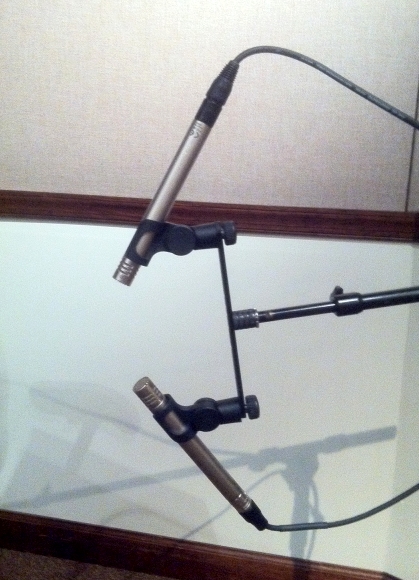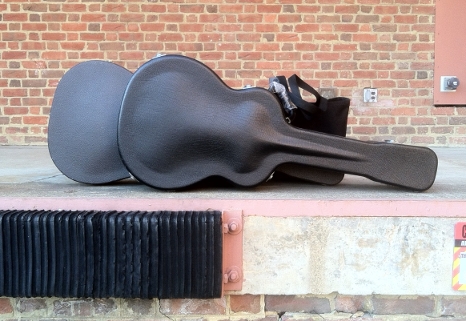Session Files: An Acoustic Challenge

THE CALL
The other day I got a call asking me to put some acoustic guitar work on a music video, no specs given other than “a few strums.” Maybe it was the way it was asked, maybe it was my “spidey-sense,” but my weird-session-o-meter was banging itself into little pieces on its right-hand stop. Usually, the more vague the call, the less technical the producer, so they have no idea how difficult the task they are requesting may be. That’s when the hairs on the back of my neck go up. Did I take the job? Of course!
I armed myself with a Taylor 710ce (six-string deadnaught) and 354ce (twelve string grand auditorium) because I had no idea what I’d be playing. I did take precautions because I expected this producer to hit the door and say, “Are you ready to roll?” I set up and got a sound before the session because the producer probably wouldn’t want to sit still for adjustments, etc. I laid out an array of picks and capos at the ready to match any sound.
For this session I came up with a novel mic’ing method: The night before, despite a heavy schedule of dreaming, I woke up at three AM with the idea for this mic’ing scheme rolling around in my head. Here’s the deal: believe it or not, a professional engineer has less time to experiment than a hobbiest. You’ve got to get a setup quickly and then get a useable product that the producer likes EVERY time so you tend to find a formula or two and stick to it. On guitar, the typical X-Y coincident pair works OK without phase issues but has two drawbacks: 1) it doesn’t produce a very wide stereo spread and 2) because of the mics’ orientation, you just about always end up with two different frequency spectrums and have to EQ if you want them to match. what occurred to me was that a mic has no absolute idea which way it is facing. How can I eliminate the spectrum issue and end up with a reasonably matched spectrum? Turn the array on its side!*

That's right, vertical. By spacing the mics and paying attention to phase coherence I can get some nice stereo interest and a strong enough center image. And so I did. I set the mics four inches apart and at approximately 110’. My signal path was:
AKG C451B > Avalon VT737 preamp, no compression or EQ > Apogee converters > Digital Router > Mac/Nuendo DAW.
I set up and balanced the mics and created extra recording channels on the DAW during lunch and set my levels conservatively because I would be both playing and engineering this mess.
SESSION TIME!
Challenges: When the producer delivered the audio and video files from the editing suite I got about ten minutes of “discovery phase” to import and figure out the ten-track, multi-track OMF file that the video editor had sent me. Then it really was, “Are you ready to roll?”
Here’s the job: The producer decided to insert a verse and chorus of a performance that was recorded a-capella in the field by a video crew into a Nashville-mixed music product. During the insert the original album mix will go away, so it needs some acoustic guitar accompaniment to make it blend. For today’s session we will have very little time – the producer is working against a release deadline and is simultaneously booked in both my studio and in a video editing suite. The product is needed yesterday, if not sooner, to take back to editing.
On the video shoot, the artist sang into a shotgun video mic with nothing except an initial pitch to anchor her. There was no click track for rhythm. Thank goodness she was pretty darn “on” for pitch but her performance had a sense of timing known only to God and the vocalista herself. I would need to match my guitar to her random entrances and then match the tone of the guitar and voice from the Nashville studio recording. I was given a lead sheet with words and chords that didn’t match the performance. Voile’! That’s it. What could go wrong?
We settled on the Taylor 710ce for the recording and took a few rehearsal passes to give me a chance to create my parts and backwards-engineer the chord changes the artist seemed to be singing to in her head. My parts were really pretty simple but the timing issues brought the complexity to the gig. I auditioned a strumming version and a fingerstyle version and the producer decided to go with fingerstyle. Then we punched into record.
After the first through pass the producer changed her mind and decided to switch to strums on the chorus. I took a second through pass to adapt. We comp’d the better performance of the verse from the first take and the requested chorus strums from the second take, made a couple of timing edits to match the vocalista’s delivery, and had our take. Now it was time to make the guitar blend with the studio version. After double-checking that the individual mic tracks balanced, I collapsed them into a single stereo track to make matched stereo processing easier. The EQ dial-in went smoothly with only a little lower-mids around 200 hz and some typical upper-mid honk from the rosewood body being moderated. Next, I add a pinch of reverb, using a “church hall” program with a long-ish three-point-eight second decay.
Now for the vocals: For this segment the gal artist was recorded out in a field pretty far from traffic, but the traffic is still there and would spoil any attempt to add reverb. I found a small section of just the traffic noise without a breath, inserted a single-ended noise reduction plug (Waves X-Noise), let the plug learn the noise, and then blended out a fair amount. After that I added an expander with a pretty deep setting and, bam-boom she’s clean. Next I inserted an EQ. First I EQ’d out the capsule resonances that every mic, and especially a shotgun, has, then did a little aesthetic EQ to pretty-up her voice. Next, I added a pinch of reverb, using another instance of the “church hall,” but this time with a more modern, one-point-eight second decay. I mixed it very low, just to add a professional sheen without seeming strange with the visuals of this gal in the middle of a field. By then, the last, held note by the vocalist was bugging me. As sometimes happens, she’s gone a bit flat as her lungs empty of air kind of like the end of a note on a set of bagpipes. If her video shoot was anywhere as rushed as my guitar session I can sympathize. I pulled in Antares Auto-Tune, put it in manual mode, redrew a couple of notes, pulled up the beginning of the last held note by a half-tone, and then tipped up the downward trajectory of that last note until it was level and on-pitch.
MIX TIME
The mix is horribly straightforward, just balancing the tracks and leveling a few wolf notes and quiet notes from the singer. I export the mixes and deliver them to the producer's server and the producer runs back to the editing suite to integrate this segment in the existing song and preparing the video for a management and focus-group viewing. With an hour and fifty minutes having elapsed from session start, I am doing the file maintenance and cleaning up the mics and cords. A half-hour later I head over to the editing suite and pay a courtesy call to make sure I’ve given the video editor what he needs. He’s ecstatic, the producer is thrilled, and I’m proud. The product passes the focus group and airs. Challenge met!

* As it turns out, I wasn't the first to come up with this mic'ing scheme and I'm not all that surprised. I understand that one of my old engineering influences, George Massenburg, is credited with first using a vertical mic array on guitars. You don't suppose some mention of this from a magazine article was floating around in my brain and came out the night before, do you? ;^)
= =
=



